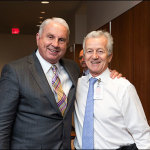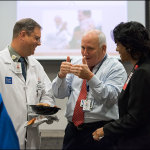Texas Children’s recently won the ECRI Institute’s 10th Annual Health Devices Achievement Award for demonstrating excellence in health technology management and patient safety.
The award-winning submission, “Alarm Management Reboot,” describes Texas Children’s successful effort to improve patient safety by incorporating enterprise-wide alarm management practices to make alarms more meaningful and actionable while eliminating alarm fatigue within patient units.
Texas Children’s alarm management steering team began with a baseline analysis of the organization’s current alarm management program. The team also laid out the Joint Commission’s National Patient Safety Goal into an action plan which designated specific operations necessary to meet the phases of the patient safety goal. Texas Children’s partnered with an outside organization to develop an alarm dashboard to enable the team to collect and analyze alarm data by care area, nurse and patient. Simple changes progressed to patient-specific alarm dashboards that helped the care team make decisions around alarm settings.
“Substantive changes were needed to shift focus from the number of alarms to actionable information based on an analytic dashboard,” said John Weimert, director of biomedical engineering at Texas Children’s. “This project aligned people, technology and governance to meet the common goal of improving patient safety.”
For the initiative’s pilot, the team targeted the progressive care unit (PCU), a step-down unit from the pediatric intensive care unit that treats critically and chronically ill patients. It was an ideal place to start because PCU patients depend on technological support and heavy monitoring, resulting in frequent alarms on the unit.
Data collected from patient monitors showed that nurses received an overwhelming number of alarms – approximately 180 per 12-hour shift. A closer look revealed that low oxygen saturation alarms made up nearly half of the total. Rarely were levels dangerously low, just small dips below that unit’s standard level of 93 percent oxygen saturation. Frequent fluctuations in oxygen saturation set off alarms constantly.
To fix the problem, the team lowered oxygen saturation alarm levels to 90 percent. The new standard was tested over a 28-day trial, during which patients also were monitored for adverse event. At the end of the trial, alarms related to low oxygen saturation levels had decreased by 10 percent, and the time patients spent in an alarm state, decreased by 9 percent. No adverse health events were reported.
Additionally, alarms data and insight from nurses revealed other small factors that made a huge impact. For example, nurses noticed that metal trash cans in shared hospital rooms made a loud noise when opened causing patients’ heart rates to spike. By replacing noisy trashcans with quieter ones, the average daily alarm time was reduced by 3 percent. The threshold for the unit’s centralized alarms notification system located in nursing stations was also adjusted from 10 seconds to one minute. Due to these changes, the unit is quieter with noise levels improving from 80 decibels – the sound of an alarm clock two feet away – to less than ambient noise level.
“The partnership among all the disciplines involved in this work was key to changing the conversation around alarms,” said Jennifer Sanders, director of Clinical Support Operations, who co-led the initiative with leaders from Information Services and Biomedical Engineering. “Without robust data and collaboration between the clinical nursing and physician staff, these improvements would not have been possible.”
Based on the initiative’s success in reducing alarm fatigue in the PCU, Sanders says the alarms management initiative has the potential to benefit other hospital units.
“The team did an admirable job of revamping their alarm management program with an in-depth assessment of the environment at the patient’s bedside,” said ECRI Institute’s David Jamison, executive director of health technology evaluation and safety. “The actionable approach Texas Children’s took to stop alarm fatigue provides a good example for hospitals nationwide.”
Click here to read the ECRI Institute’s article about Texas Children’s award-winning alarm management strategy.













